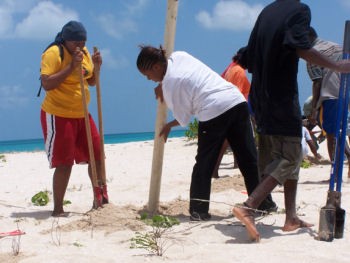
The Codrington Lagoon on the small island of Barbuda is exceptionally rich in biodiversity. It also protects the small village of Codrington and its 1,300 inhabitants against storms surges and swells. Yet recently local authorities began to fear the lagoon could no longer protect against increasingly intense storms that threatened their fisheries and eco-tourism, backbones of the island's economy.
To help address these concerns, USAID through its Caribbean Open Trade Support program fielded a coastal zone engineer to measure the threat. The study indicated that a Category 3 hurricane could seriously alter the lagoon's ecology, putting Codrington's key infrastructure under water. Upon hearing this, local stakeholders responded immediately by enlisting the entire community to build sand-trapping fences and re-vegetate the area.
A local businessman shipped US-made fencing from Antigua to Barbuda for free. A local hotel offered its lagoon-adapted speed craft to transport the material across the lagoon. Then about 75 community volunteers, worked non-stop to help build the storm protection they so badly needed. "Once we explained what the fences would do, the community came out and finished building them ahead of schedule," said John Mussington, principal of the local Sir McChesney George Secondary School.
In less than three weeks, 4,320 feet of fences were built. In addition, based on similar project in Chesapeake Bay, MD, COTS helped construct a state-of-the-art greenhouse to assist with plant propagation and re-vegetation. The greenhouse is now part of the school's curriculum so students can learn about the flora's unique and fragile environment and its contribution to conservation.
Over two years, the fences are expected to create a four-foot bank that will better secure the lagoon and the people of Barbuda.
In less than three weeks, 4,320 feet of sand fences and a greenhouse were built to protect Barbuda's Codrington Lagoon and increase vegetation.







Comment
Make a general inquiry or suggest an improvement.